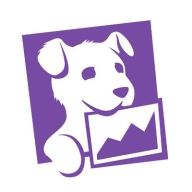

Datadog and Elastic Security are key competitors in the monitoring and security space, with Datadog taking the lead due to its comprehensive feature set, despite pricing concerns highlighted by users.
Features: Datadog provides extensive custom event tracking, advanced observability, and AI assistance, enhanced by a wide range of integrations. Its application performance monitoring and alerting capabilities enrich quick incident responses across extensive dashboards. Elastic Security, as an open-source solution, offers scalable threat detection and data visualization, effectively managing vast data volumes with robust search capabilities.
Room for Improvement: Datadog users face challenges with pricing complexity and desire greater cost control alongside extended customization options. Improved session replay features and enhanced integrations are also noted needs. Elastic Security requires better automation, more straightforward dashboards, and streamlined query functionalities. Users report a learning curve and complex setup, highlighting the need for more integrated and intelligent features out of the box.
Ease of Deployment and Customer Service: Datadog supports Public, Private, and Hybrid Cloud deployments, offering strong customer service with quick technical support, making it appealing for proactive support needs. Elastic Security is suited for On-premises and Hybrid Cloud environments, with support supplemented by open-source community contributions, though company-led support can be slower.
Pricing and ROI: Datadog has a variable pricing model that can become costly with high data ingestion. While users find value in reduced downtime and expedited issue resolutions, cost management remains a concern. Elastic Security's cost-effective open-source model, with certain premium features, offers ROI through large-scale monitoring cost savings, appealing to those prioritizing cost-efficient open-source solutions.
Previously we had thirteen contractors doing the monitoring for us, which is now reduced to only five.
Datadog has delivered more than its value through reduced downtime, faster recovery, and infrastructure optimization.
I believe features that would provide a lot of time savings, just enabling you to really narrow down and filter the type of frustration or user interaction that you're looking for.
It does not require hefty security budgets and can be deployed for enterprise security effectively.
When I have additional questions, the ticket is updated with actual recommendations or suggestions pointing me in the correct direction.
Overall, the entire Datadog comprehensive experience of support, onboarding, getting everything in there, and having a good line of feedback has been exceptional.
I've had a couple instances where I reached out to Datadog's support team, and they have been really super helpful and very kind, even reaching back out after resolving my issues to check if everything's going well.
Support is prompt and helpful.
Most of the time when my team encounters issues, they receive responses within 24 hours.
I have not faced any difficulties with Elastic Security, as we have a pretty good support service from them.
Datadog's scalability has been great as it has been able to grow with our needs.
We did, as a trial, engage the AWS integration, and immediately it found all of our AWS resources and presented them to us.
Datadog's scalability is strong; we've continued to significantly grow our software, and there are processes in place to ensure that as new servers, realms, and environments are introduced, we're able to include them all in Datadog without noticing any performance issues.
It allows us to think about specific use cases, such as gathering malicious IPs in a single view and analyzing threats based on geolocation.
Elastic Security is quite scalable.
Datadog is very stable, as there hasn't been any downtime or issues since I've been here, and it's always on time.
Datadog seems stable in my experience without any downtime or reliability issues.
These incidents are related to log service, indexes, and metric capturing issues.
In terms of stability, I would rate Elastic a solid eight out of ten.
It would be great to see stronger AI-driven anomaly detection and predictive analytics to help identify potential issues before they impact performance.
The documentation is adequate, but team members coming into a project could benefit from more guided, interactive tutorials, ideally leveraging real-world data.
In future updates, I would like to see AI features included in Datadog for monitoring AI spend and usage to make the product more versatile and appealing for the customer.
CrowdStrike and Defender have more established threat intelligence integration due to having a larger client base.
My security testing team continuously reports vulnerabilities, and we have to fix and update the versions frequently.
Machine learning algorithms become better with time; as they ingest a huge volume of data, they become better.
The setup cost for Datadog is more than $100.
Everybody wants the agent installed, but we only have so many dollars to spread across, so it's been difficult for me to prioritize who will benefit from Datadog at this time.
My experience with pricing, setup cost, and licensing is that it is really expensive.
The pricing is reasonable, especially for Small Medium Enterprises (SMEs), making it a viable option for businesses building their security infrastructure.
This is beneficial for SMEs as they do not need extensive budgets for security solutions.
Elastic Security is considered cost-effective, especially at lower EPS levels.
Our architecture is written in several languages, and one area where Datadog particularly shines is in providing first-class support for a multitude of programming languages.
Having all that associated analytics helps me in troubleshooting by not having to bounce around to other tools, which saves me a lot of time.
Datadog was able to find the alerts and trigger to notify our team in a very prompt manner before it got worse, allowing us to promptly adjust and remediate the situation in time.
Elastic Security offers good insight regarding alerts, reports, and cases.
Elastic Security offers advanced features such as machine learning and integration with ChatGPT.
We require rapid processing speed for alerts and event data, and Elastic Security is very efficient at handling this level of data.
| Product | Market Share (%) |
|---|---|
| Datadog | 5.4% |
| Elastic Security | 2.9% |
| Other | 91.7% |


| Company Size | Count |
|---|---|
| Small Business | 80 |
| Midsize Enterprise | 46 |
| Large Enterprise | 95 |
| Company Size | Count |
|---|---|
| Small Business | 40 |
| Midsize Enterprise | 11 |
| Large Enterprise | 15 |
Datadog integrates extensive monitoring solutions with features like customizable dashboards and real-time alerting, supporting efficient system management. Its seamless integration capabilities with tools like AWS and Slack make it a critical part of cloud infrastructure monitoring.
Datadog offers centralized logging and monitoring, making troubleshooting fast and efficient. It facilitates performance tracking in cloud environments such as AWS and Azure, utilizing tools like EC2 and APM for service management. Custom metrics and alerts improve the ability to respond to issues swiftly, while real-time tools enhance system responsiveness. However, users express the need for improved query performance, a more intuitive UI, and increased integration capabilities. Concerns about the pricing model's complexity have led to calls for greater transparency and control, and additional advanced customization options are sought. Datadog's implementation requires attention to these aspects, with enhanced documentation and onboarding recommended to reduce the learning curve.
What are Datadog's Key Features?In industries like finance and technology, Datadog is implemented for its monitoring capabilities across cloud architectures. Its ability to aggregate logs and provide a unified view enhances reliability in environments demanding high performance. By leveraging real-time insights and integration with platforms like AWS and Azure, organizations in these sectors efficiently manage their cloud infrastructures, ensuring optimal performance and proactive issue resolution.
Elastic Security combines the features of a security information and event management (SIEM) system with endpoint protection, allowing organizations to detect, investigate, and respond to threats in real time. This unified approach helps reduce complexity and improve the efficiency of security operations.
Additional offerings and benefits:
Finally, Elastic Security benefits from a global community of users who contribute to its threat intelligence, helping to enhance its detection capabilities. This collaborative approach ensures that the solution remains on the cutting edge of cybersecurity, with up-to-date information on the latest threats and vulnerabilities.
We monitor all Log Management reviews to prevent fraudulent reviews and keep review quality high. We do not post reviews by company employees or direct competitors. We validate each review for authenticity via cross-reference with LinkedIn, and personal follow-up with the reviewer when necessary.